Amazon EKS – Now Generally Available

|
We announced Amazon Elastic Container Service for Kubernetes and invited customers to take a look at a preview during re:Invent 2017. Today I am pleased to be able to let you know that Amazon EKS
Based on the most recent data from the Cloud Native Computing Foundation, we know that AWS is the leading environment for Kubernetes, with 57% of all companies who run Kubernetes choosing to do so on AWS. Customers tell us that Kubernetes is core to their IT strategy, and are already running hundreds of millions of containers on AWS every week. Amazon EKS
AWS Inside
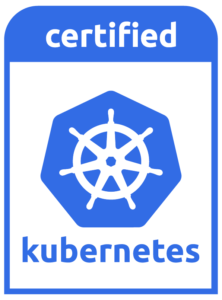 Amazon EKS takes advantage of the fact that it is running in the
Amazon EKS takes advantage of the fact that it is running in the
Multi-AZ – The Kubernetes control plane (the API server and the etcd database) are run in high-availability fashion across three AWS Availability Zones. Control plane nodes are monitored and replaced if they fail, and are also patched and updated automatically.
IAM Integration – Amazon EKS uses the Heptio Authenticator for authentication. You can make use of IAM roles and avoid the pain that comes with managing yet another set of credentials.
Load Balancer Support – You can route traffic to your worker nodes using the AWS Network Load Balancer, the AWS Application Load Balancer, or the original (classic) Elastic Load Balancer.
Route 53 – The External DNS project allows services in Kubernetes clusters to be accessed via Route 53 DNS records. This simplifies service discovery and supports load balancing.
Auto Scaling – Your clusters can make use of Auto Scaling, growing and shrinking in response to changes in load.
Container Interface – The Container Network Interface for Kubernetes uses Elastic Network Interfaces to provide secondary IP addresses for Kubernetes Pods.
Amazon EKS is built around a shared-responsibility model; the control plane nodes are managed by AWS and you run the worker nodes. This gives you high availability and simplifies the process of moving existing workloads to EKS. Here’s a very high-level overview:
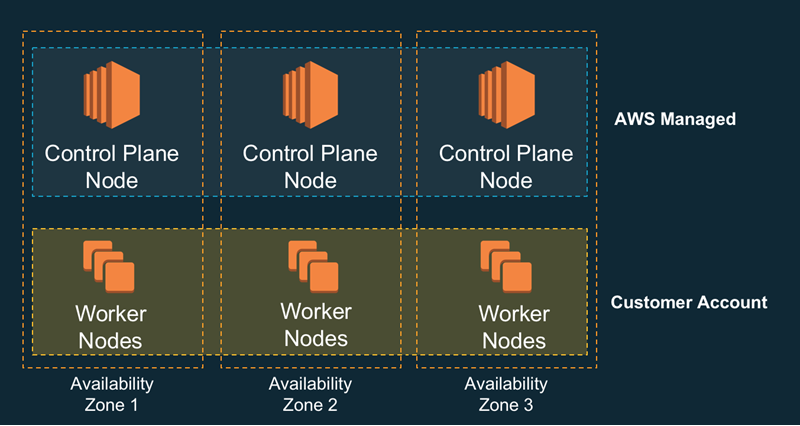
Creating an Amazon EKS Cluster
To create a cluster, I provision the control plane, provision and connect the worker cluster, and launch my containers. In the example below I will create a new VPC for my worker cluster, but I can also use an existing one, as long as the desired subnets are tagged with the name of my Kubernetes cluster.
Following the directions in the Amazon EKS Getting Started Guide, I begin by creating an IAM role. Kubernetes assumes this role and uses it to create AWS resources such as Elastic Load Balancers. Once created, this role can be used for all of my clusters.I open up the IAM console, click Create role, select EKS, and click Next:Permissions:

The policies look good, so I click Next:Review:

I enter a name for my role, and click Create role:
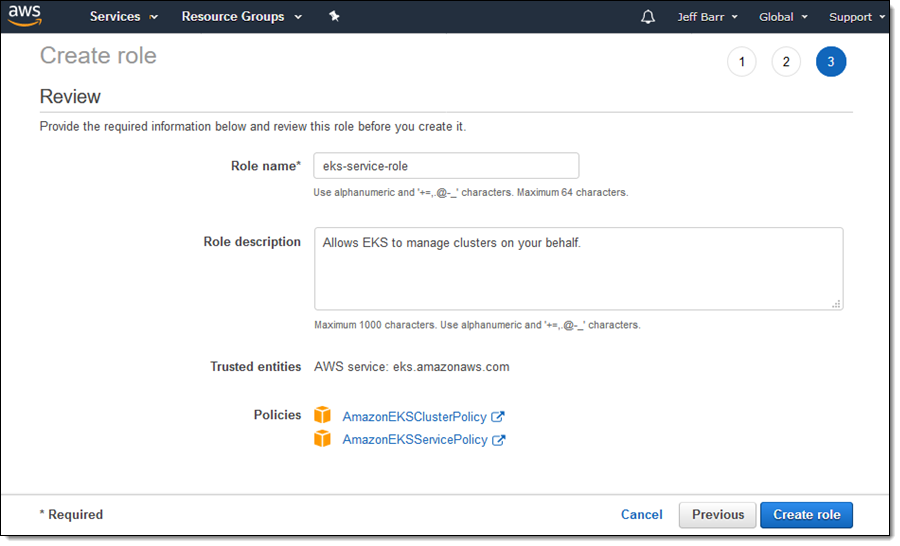
Next, I create a VPC (Virtual Private Cloud) using the sample template from the Getting Started Guide, with the following parameters:
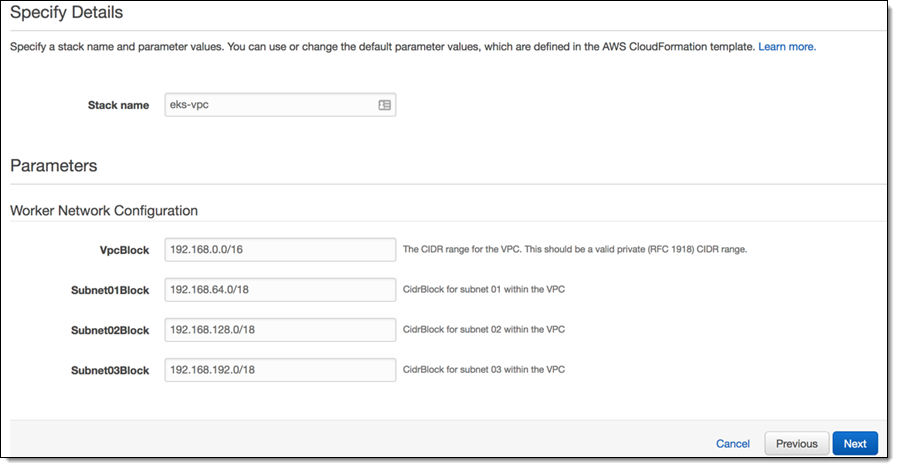
The template creates a VPC that has three subnets, along with all of the necessary route tables, gateways, and security groups):
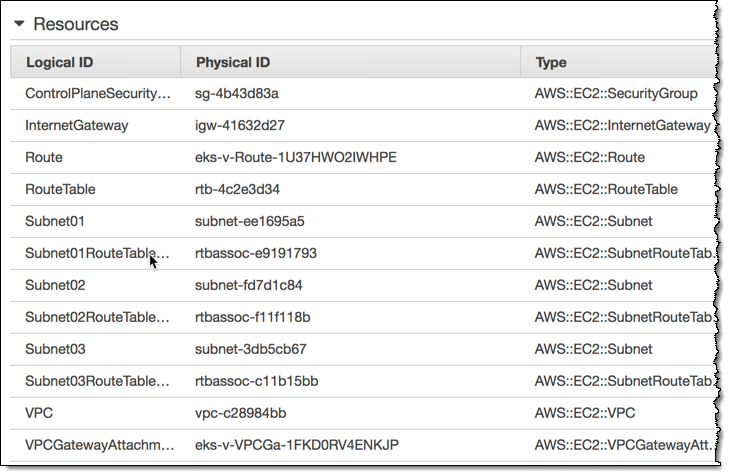
As is the case with the ARN, I will need the ID of the security group later:

Next, I download kubectl and set it up to use the Heptio Authenticator. The authenticator allows kubectl to make use of IAM authentication when it accesses my Kubernetes clusters. Instructions for downloading and setup are in the Getting Started Guide and I follow them as directed.
To wrap up the setup process, I ensure that I am running the latest version of the AWS Command Line Interface (CLI) by running eks help (if I was running an older version, the eks command would not be available):

With my IAM role, my VPC, and my tooling all in place, I am ready to create my first Amazon EKS cluster!
I log in to the EKS Console using an IAM user that has administrative privileges (root credentials cannot be used due to the way that the Heptio Authenticator works) and click Create cluster:

I enter a name for my cluster (which must match the one that I entered when I created the VPC, because Kubernetes relies on tagging of subnets), along with the subnet IDs and the security group ID, both for the VPC, and click Create:
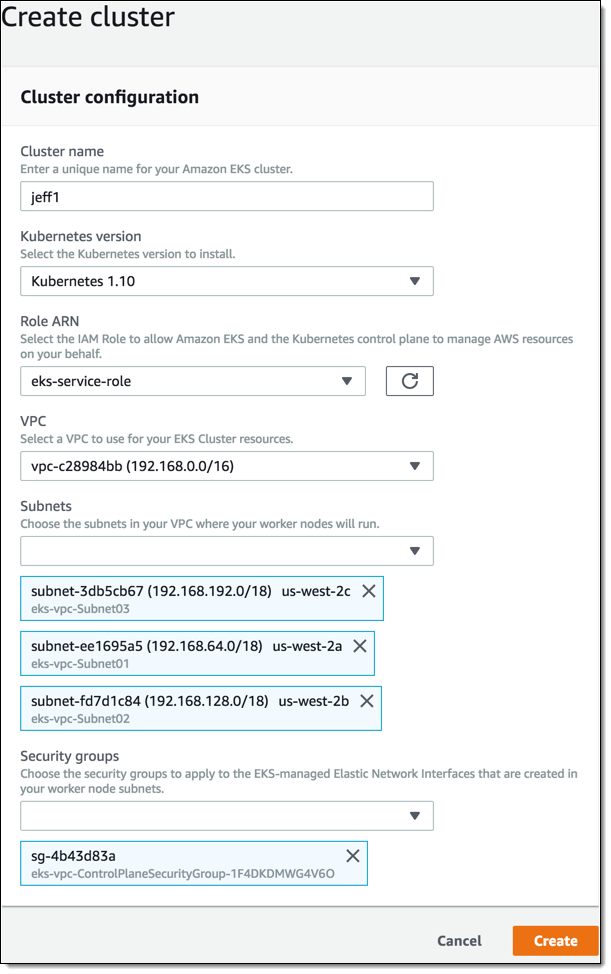
My control plane cluster starts out in CREATING status, and transitions to ACTIVE in 10 minutes or less:

Now I need to configure kubectl so that it can access my cluster. Before I can do this, I need to use the CLI to retrieve the certificate authority data:
$ aws eks describe-cluster --region us-west-2 --name jeff1 --query cluster.certificateAuthority.data
This command returns a long string of data that I’ll need in a minute.
I also retrieve the cluster endpoint from the console:
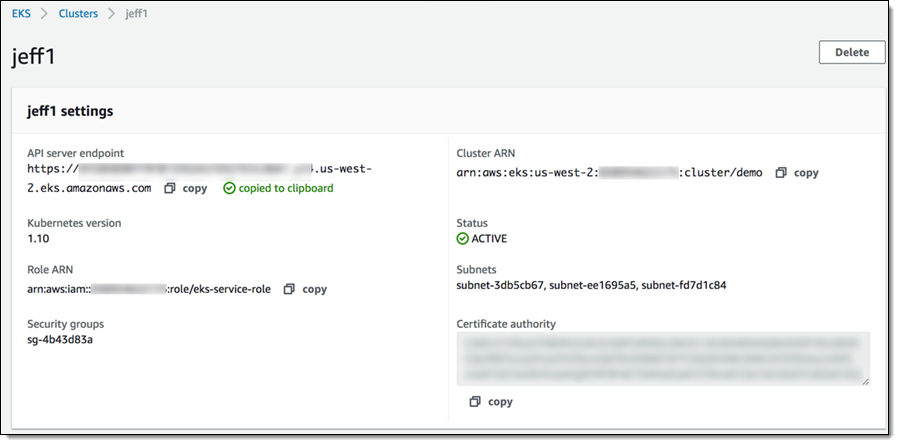
I can also retrieve the endpoint using the CLI:
$ aws eks describe-cluster --region us-west-2 --name jeff1 --query cluster.endpointI make sure that I am in my home directory, create sub-directory .kube, and create file config-jeff1 in it. Then I open config-jeff1 in my editor, copy the templated config file from the Getting Started Guide and finalize the cluster endpoint, certificate, and cluster name. My file looks like this:
apiVersion: v1
clusters:
- cluster:
server: https://FDA1964D96C9EEF2B76684C103F31C67.sk1.us-west-2.eks.amazonaws.com
certificate-authority-data: "...."
name: kubernetes
contexts:
- context:
cluster: kubernetes
user: aws
name: aws
current-context: aws
kind: Config
preferences: {}
users:
- name: aws
user:
exec:
apiVersion: client.authentication.k8s.io/v1alpha1
command: heptio-authenticator-aws
args:
- "token"
- "-i"
- "jeff1"
Before I test kubectl, I need to ensure that my CLI is configured to use the same IAM user that I used when I logged in to the console to create the cluster:

And now I can run a quick test to verify that everything is working as expected:

At this point I have set up my control plane VPC and my Kubernetes control plane. I’m ready to create some worker nodes (EC2 instances). Once again, this is done using a CloudFormation template:
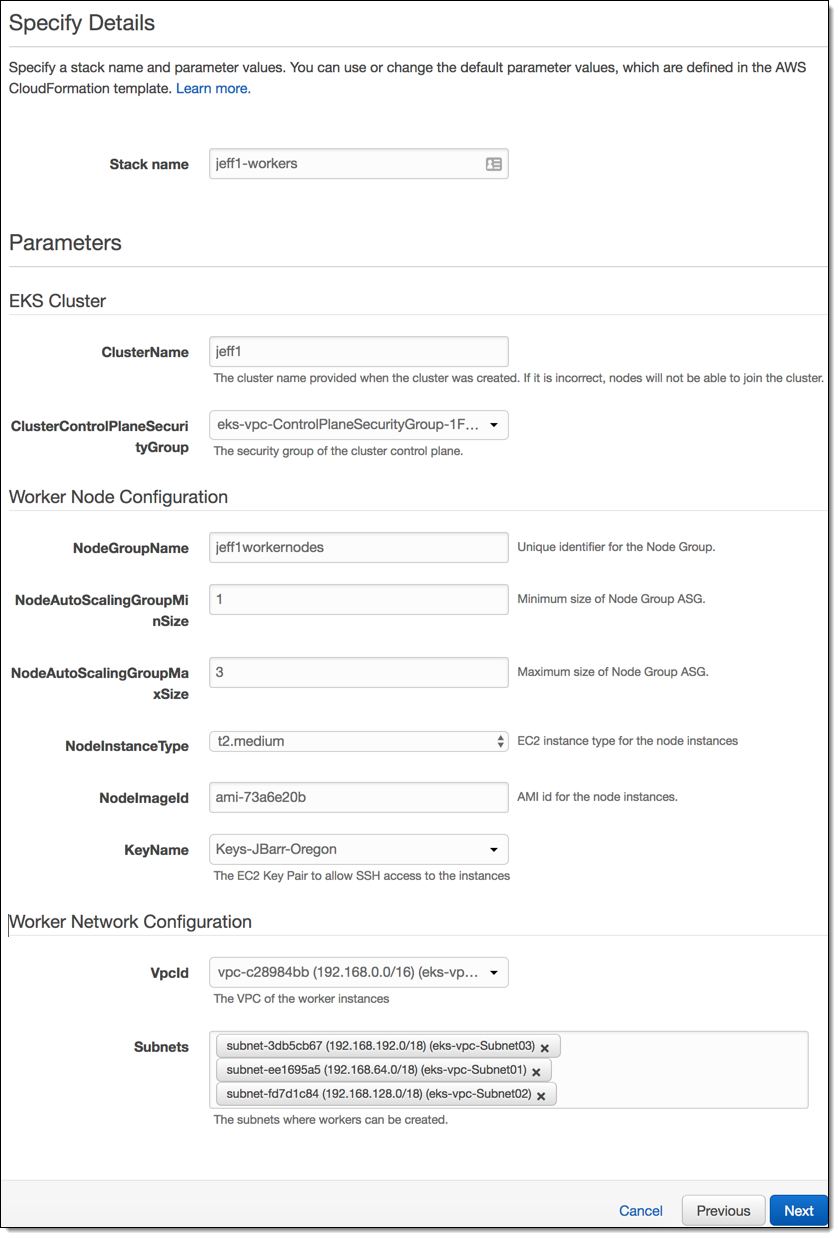
The stack is created in a couple of minutes and sets up IAM roles, security groups, and auto scaling. I’ll need the ARN of the NodeInstanceRole:

Now I need to set up a configurator map so that the worker nodes know how to join the cluster. I download the map, add the ARN of the NodeInstanceRole from the stack, and apply the configuration:
$ curl -O https://amazon-eks.s3-us-west-2.amazonaws.com/1.10.3/2018-06-05/aws-auth-cm.yaml
% Total % Received % Xferd Average Speed Time Time Time Current
Dload Upload Total Spent Left Speed
100 282 100 282 0 0 347 0 —:--:— --:—:-- —:--:— 347
$ vim aws-auth-cm.yaml
$ kubectl apply -f aws-auth-cm.yaml
configmap "aws-auth" createdThen I check and see that my nodes are ready:

Running the Guest Book Sample
My Kubnernetes cluster is all set and I can use the Guest Book application to test it out. I create the Kubernetes replication controllers and services:
$ kubectl apply -f https://raw.githubusercontent.com/kubernetes/kubernetes/v1.10.0/examples/guestbook-go/redis-master-controller.json
replicationcontroller "redis-master" created
$ kubectl apply -f https://raw.githubusercontent.com/kubernetes/kubernetes/v1.10.0/examples/guestbook-go/redis-master-service.json
service "redis-master" created
$ kubectl apply -f https://raw.githubusercontent.com/kubernetes/kubernetes/v1.10.0/examples/guestbook-go/redis-slave-controller.json
replicationcontroller "redis-slave" created
$ kubectl apply -f https://raw.githubusercontent.com/kubernetes/kubernetes/v1.10.0/examples/guestbook-go/redis-slave-service.json
service "redis-slave" created
$ kubectl apply -f https://raw.githubusercontent.com/kubernetes/kubernetes/v1.10.0/examples/guestbook-go/guestbook-controller.json
replicationcontroller "guestbook" created
$ kubectl apply -f https://raw.githubusercontent.com/kubernetes/kubernetes/v1.10.0/examples/guestbook-go/guestbook-service.json
service "guestbook" created
I list the running services and capture the external IP address & port:

and visit the address in my web browser:
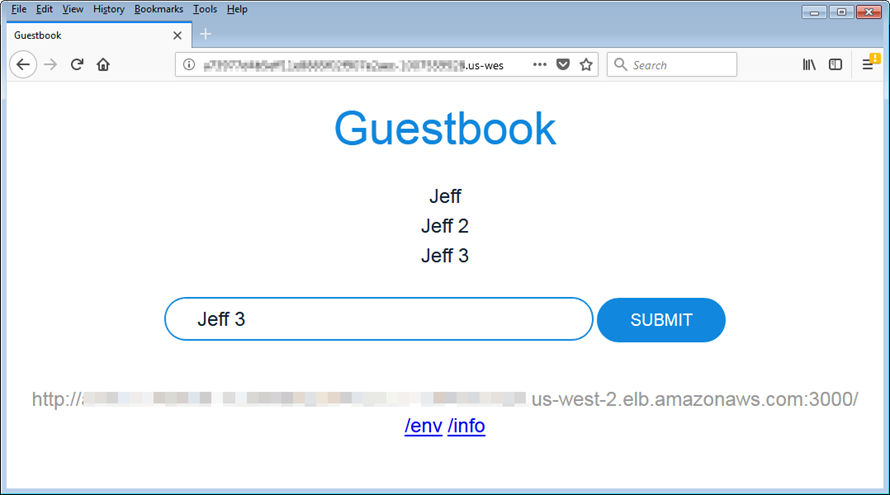
Things to Know
We make upstream contributions to the Kubernetes repo and to projects such as the CNI Plugin, the Heptio AWS Authenticator, and Virtual Kubelet. We are currently looking for Systems Development Engineers, DevOps Engineers, Product Managers, and Solution Architects with Kubernetes experience; check out the full list of open positions to learn more.
Amazon EKS is available today in the US East (N. Virginia) and US West (Oregon) Regions and will be expanding to others very soon. We have a detailed roadmap and plan to crank out plenty of additional features this year.
You pay $0.20 per hour for the EKS Control Plane, and usual EC2, EBS, and Load Balancing prices for resources that run in your account. See the EKS Pricing page for more information.
— Jeff;
PS – Special thanks to my colleague Tiffany Jernigan, for supplying me with an updated set of screen shots!
相關推薦
Amazon Cognito Your User Pools – Now Generally Available
A few months ago I wrote about the new Your User Pools feature for Amazon Cognito. As I wrote at the time, you can use this feature to easily add
Go for App Engine is now generally available
21 July 2011 The Go and App Engine teams are excited to announce that the Go runtime for App Engine is now g
IoT Analytics Now Generally Available
Today, I’m pleased to announce that, as of April 24th 2018, the AWS IoT Analytics service is generally available. Customers can use IoT Analytics
Amazon Aurora Parallel Query is Generally Available
Amazon Web Services is Hiring. Amazon Web Services (AWS) is a dynamic, growing business unit within Amazon.com. We are currently hiring So
Amazon Neptune Generally Available
Amazon Neptune is now Generally Available in US East (N. Virginia), US East (Ohio), US West (Oregon), and Europe (Ireland). Amazon Neptune is a fa
Amazon EKS Enables Support for Kubernetes Dynamic Admission Controllers
Amazon Web Services is Hiring. Amazon Web Services (AWS) is a dynamic, growing business unit within Amazon.com. We are currently hiring So
Amazon QuickSight now supports Email Reports and Data Labels
Today, we are excited to announce the availability of email reports and data labels in Amazon QuickSight. Email reports With email
Amazon EKS Pricing
You pay $0.20 per hour for each Amazon EKS cluster that you create. You can use a single Amazon EKS cluster to run multiple applications by taking
Continuous Delivery with Amazon EKS and Jenkins X
Amazon Elastic Container Service for Kubernetes (Amazon EKS) provides a container orchestration platform for building and deploying modern cloud a
Securing Amazon EKS Using Lambda and Falco
Intrusion and abnormality detection are important tools for stronger run-time security in applications deployed in containers on Amazon EKS cluste
Amazon EKS Features
Amazon EKS makes it easy to provide security for your Kubernetes clusters, with advanced features and integrations to AWS services and technology
Getting Started with Amazon EKS
Amazon Web Services is Hiring. Amazon Web Services (AWS) is a dynamic, growing business unit within Amazon.com. We are currently hiring So
Improvements for Amazon EKS Worker Node Provisioning
Amazon Elastic Container Service for Kubernetes (EKS) provides an optimized Amazon Machine Image (AMI) and AWS CloudFormation template th
Introducing Horizontal Pod Autoscaling for Amazon EKS
The Horizontal Pod Autoscaler and Kubernetes Metrics Server are now supported by Amazon Elastic Container Service for Kubernetes
Amazon EKS の料金
作成した Amazon EKS クラスターごとに、1 時間あたり 0.20 USD の料金が発生します。Kubernetes の名前空間と IAM セキュリティポリシーを活用すると、Amazon EKS クラスター 1 つで複數のアプリケーションを実行することができます。 Kubernet
Getting Started with Istio on Amazon EKS
Service Meshes enable service-to-service communication in a secure, reliable, and observable way. In this multi-part blog series, Matt Turner, fou
Amazon EKS よくある質問
Q: Amazon EKS を使用する利點は何ですか? Amazon EKS は、API ダーバーやバックエンド永続レイヤーなどの Kubernetes コントロールプレーンを複數の AWS アベイラビリティーゾーンをまたいでプロビジョン、スケールして、高可用
Amazon EKS Kubernetes託管_kubernetes叢集管理服務
藉助 Amazon Elastic Container Service for Kubernetes (Amazon EKS),您可以在 AWS 上使用 Kubernetes 輕鬆部署、管理和擴充套件容器化應用程式。 Amazon EKS 跨多個 AWS 可用區為您執行 Ku
